
Let me begin by saying, I’m usually pretty sceptical when it comes to wellness trends. I’ve been scarred from using Instagram in the 2010s as a teenager, when my feed was full of smoothie bowls and annoying, inspirational quotes.
Now, health trends have been repackaged as bio-hacking for gym bros, revolving mostly around cold exposure therapy, gut health and resetting your nervous system.
For more perspectives on wellness, head on over to our Health section.
I understand the appeal, to an extent. It’s a way to feel like you’re taking control of your health to ultimately, help you feel better. But at my most cynical, the wellness discourse feels a little too self-indulgent and privileged. Plus, if something sounds too good to be true (like reversing ageing), it’s because it is.
But as I’ve gotten older, I’m starting to realise how interrelated my inner and outer worlds are. Not getting enough sleep makes me feel terrible the next day, and not moving my body makes me feel stiff and sore (shocker). Rather than letting myself feel pressured into wellness trends, I’ve been gravitating towards habits that are guided by intuition, not appearance.
When I came across the Ultrahuman Ring Air, I was in two minds. I’d never been tempted by a smart watch or Fitbit before, but something about this ring caught my attention. For one, it was tiny. Given the amount of information it promised to capture, it seemed so little and compact.
I also liked that it wasn’t connected to social media, nor was it hyper-focused on fitness and calorie tracking. Instead, it was meant to provide deep insights into your sleep, stress levels and menstrual cycle. Feeling curious, I reached out to Ultrahuman to see if I could try it out and it arrived around two weeks later. Since getting the Ultrahuman Air Ring, I’ve turned into Frodo Baggins. Throughout a packed Australian Fashion Week, to showering and sleeping, the only times I reluctantly take it off is to charge it.

What is the Ultrahuman Ring Air?
The Ultrahuman Ring Air is a range of personalised, data-driven health insights packaged into one sleek little ring. It’s a bit like a smartwatch, but with no display, and it’s a lot lighter. In fact, Ultrahuman say its ring is 11 times lighter, rivalling the weight of a U.S penny (random). It retails for about $599 AUD, plus an extra ten dollars for the sizing kit. It’s also subscription-free, so once you buy, you’re automatically granted access to the app. Unlike the popular Oura ring, there’s no subscriptions or additional payments required.
How the smart ring works
The Ultrahuman Ring Air tracks your heart rate, body temperature, stress and more through a range of in-built features. It’s equipped with a six-axis motion sensor that monitors your body’s movement, a non-contact temperature sensor and photoplethysmography (PPG) sensors that, all together, capture a detailed overview of your health. It uses Bluetooth to transmit data to the app and can sync for automatic firmware updates.
The ring’s battery life lasts between four to six days, and it takes precisely 180 minutes to fully charge from zero per cent to 100. It’s also waterproof, so you don’t need to take it off when you’re washing your hands, showering or swimming.
From your menstrual cycle to stress levels, here’s everything it tracks
Productivity
There is no shortage of health insights – from the best time to consume caffeine, to tracking your ovulation. So let’s break it down, starting with productivity. Towards the top of the app, each morning is your circadian alignment. This suggests the best times to expose yourself to natural sunlight and when to avoid light so you can start winding down for the day. Other elements factor into this, like maintaining a regular sleep schedule, as well as avoiding large meals and intense exercise before bed. Effectively, disrupted circadian rhythms can lead to worse health outcomes.
The ring also uses your body’s circadian rhythms to track your body’s sensitivity to caffeine, helping predict a timeframe that will boost your energy, while ensuring you still get a restful sleep. This relates a little to your sleep cycle, with the ‘adenosine clearance window’ encouraging you to delay caffeine intake by 120 minutes after waking up. You can also opt into other productivity insights, like vitamin D exposure and screen-time tracking.
Movement
Then, there’s movement. The ring tracks your physical activity through a range of sensors, taking stock of how many steps you do and how much distance you cover. You can also input exercise and food into the app, and access calorie insights.
Sleep
The Ultrahuman Air Ring’s sleep tracking is another major drawcard. It monitors your sleep stages and how much time you spend in REM, light and deep sleep, as well as how restless you are and how many hours of sleep you’re clocking. It also offers insights into your morning alertness, your heart rate and whether you’re accumulating a sleep debt, and gives you a comprehensive sleep score.
Recovery
The recovery section is based on physiological markers, The most interesting category here is definitely the ‘stress rhythm’. This shows whether you’re relaxed, stimulated or stressed. This is on a combination of analytics from your heart rate (HR), resting heart (RHR) and heart rate variability (HRV).
Menstrual cycle
Last of all is the ring’s cycle tracking. This feature monitors each key phase, from menstrual to follicular, ovulation and luteal, using both self-driven period logs and biomarkers like your temperature and heart rate. You can set goals, so if you’re trying to conceive, it will provide detailed information on your fertility and when you’re ovulating, as well as detailed health metrics if you’re pregnant.

Trying it out
The Ultrahuman sizing kit arrived first. This was a small box with a range of plastic rings in ten different sizes, which the company recommend testing out by wearing for at least two days. This was actually super helpful – the size I first went for ended up feeling too loose after a night’s wear, so I ended up going for something tighter. My kit also came with a sample of each colour way, including raw titanium, aster black, matte grey, bionic gold and space silver, but I went nice and safe with the gold option.
The ring arrived within a day or two of sending my sizing through and came in a box with a charger, information pack, tote bag and pair of blue light glasses. I charged it up. downloaded and app and started wearing it as soon as (humanly) possible. It took a couple of weeks to gather some of my health insights, but others, like my sleep score, heart rate, movement and stress levels were almost immediate.
What I loved
I become hooked on my stress levels straight away. Initially, it felt validating but a month or so on, I now see my stress score as an area for improvement, rather than something to show off. Sure, there are moments throughout the week where it’s natural, even helpful, to be stressed or stimulated.
But looking back, I’ve noticed my stress levels tend to peak in early in the day, at around 7:45am to 9:30am. Reflecting on it, I don’t like that my mornings seem to consistently start with a flood of stress. However, being able to see this documented holds me accountable in a way I wouldn’t be otherwise. The app also offers a range of ‘breathing protocols’, from five-minute diaphragmatic breathing sessions that aim to lower your heart rate, to 30-minute soma breath-work sessions, which increase your heart rate.
The caffeine window has been another point of obsession. Even as I’m writing this, my phone has been altered that my window is now ‘drawing to a close’ and that if I want a good sleep, I should probably avoiding consuming any stimulants. The mornings are no different – usually I’d be half asleep, stumbling over to the coffee machine, but apparently that’s not suggested.
Call it placebo or not, but since becoming more tuned into my caffeine habits, I’ve realised how often I crash when having a coffee first thing. Since delaying my morning coffee to around 9:30am, I’ve felt myself lasting throughout the day.
I’ve also become a fan of the little movement notifications it gives you. My daily steps goal is 11,000 per day (safe to say, I’ve never actually hit this), but the app will track how many steps you’ve done and remind you to take periodic movement breaks away from the desk.
What I had to learn to love
It’s been a challenge trying to wrap my head around other metrics, like HRV. No matter how many times I Google it or ask my friends to break it down for me, I’m only now starting to understand what it means. However, last week, the ring sent through a notification, informing me that my HRV dropped significantly below my baseline.
Apparently, this is an early sign of immune system stress, or impending sickness. Funnily enough, this came a day or so before I did start getting sick. Now, I’m even more intrigued to try and learn more about my HRV and its psychic abilities.
There are other features, I’m sure, that I don’t pay enough attention to. Some people might feel overwhelmed by the influx of information it gives you but I’ve adopted a ‘take it or leave it’ approach. Rather than feel as though I need to master everything immediately, it’s been far more enjoyable picking and choosing what I want to focus on.

Would I recommend it?
As someone who spends a lot of time in their head and less time in tune with their body, the Ultrahuman Ring Air has helped significantly in shifting my focus. It’s held me accountable, witnessing my body and health in a way I never have.
It’s never made me think about how I look, or how much I weigh. Instead, every metric (at least, the ones that I’ve been focusing on) has been about reducing my stress, lowering my heart rate and getting a better sleep. If that’s what wellness is, then I’m far more inclined to subscribe to it.
In saying that, there’s no denying the elephant in the room: it’s almost six hundred dollars. I’d say if you’re weighing up a smart watch or smart ring, the latter is a clear winner for me. It’s small, subtle and you hardly ever notice that you’re wearing it. The Oura ring in comparison isn’t much cheaper either, especially when you factor in the ten dollar per month subscription.
The past month has largely been about familiarising myself with the smart ring and trying to take in the onslaught of information it gives you – the next month is going to be focused on lowering that stress score.
For more on the science behind the Ultrahuman Ring Air, try this.
This article I become an ultrahuman for a month by testing a $600 smart ring appeared first on Fashion Journal.
2025-06-12 12:48:00
#ultrahuman #month #testing #smart #ring
Source link
















